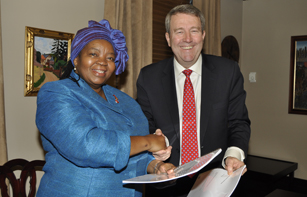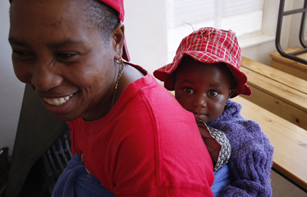
The members of the High-Level Taskforce for Women, Girls, Gender Equality and HIV for Eastern and Southern Africa during their recent visit to South Africa
The High-Level Taskforce for Women, Girls, Gender Equality and HIV for Eastern and Southern Africa concluded a week-long political advocacy mission to South Africa calling for renewed commitment and leadership to protect the health and rights of young women and girls in the country.
South Africa’s Department of Women, Children and People with Disabilities invited the Taskforce to advocate with the country’s leadership around the critical issues facing women and girls today including teenage pregnancy, gender based-violence, transmission of HIV from mother-to-child, and sex work.
“The work done by the Taskforce will help us identify gaps and challenges which will enable us to develop more effective intervention programmes,” said the Deputy Minister of the Department of Women, Children and People with Disabilities, Ms Hendrietta Bopane-Zulu.
The members of the Taskforce met with South Africa’s high-level government officials, representatives of international and civil society organisations, parliamentarians and other stakeholders working on the HIV response. The delegation also held discussion with networks of women living with HIV and lesbian, gay, bisexual transgender, and intersex (LGBTI) communities.
High teenage pregnancy
Despite South Africa’s progress in the AIDS response, women and girls remain disproportionately affected by the epidemic. According to the 2008 Human Sciences Research Council (HSRC) household survey, HIV prevalence was more than four times higher in women aged 20–24 (21.1%) than in men in the same age group (5.1%).
We have all the necessary policies in place but our biggest challenge is changing societal attitudes
South Africa’s Deputy President Kgalema Motlanthe
Social determinants such as poverty, inequalities, gender based violence, and limited access to sexual and reproductive health information together with a lack of adolescent friendly health services make teenage girls vulnerable to unintended pregnancy and HIV infection. Data from the National Strategic Plan on HIV, TB and STIs, 2012–2016 shows that 39% of 15–19-year-old girls have been pregnant at least once and 49% of adolescent mothers are pregnant again in the subsequent 24 months. It also reveals that one in five pregnant adolescents is HIV-positive.
“We are doing everything possible to end teenage pregnancies, which are primarily caused by older men taking advantage of young girls,” said South Africa’s Deputy President Kgalema Motlanthe. “We have all the necessary policies in place but our biggest challenge is changing societal attitudes,” added Dr Motlanthe.
The Taskforce team engaged with the King Goodwill Zwelithini of KwaZulu-Natal Province regarding traditional and social norms, such as intergenerational sex and multiple and concurrent partnerships that contribute towards the issue of teenage pregnancy. "We should not only focus on youth programmes,” said King Zwelithini. “We must also educate parents at home because some parents find it hard to talk to their children. It is not easy but we should speak the truth, because the love of truth is the spirit of men," he added.
“Prevention of unintended pregnancies and HIV infection in young girls must be a major priority for South Africa’s leadership”, said Professor Sheila Tlou, Regional Director of UNAIDS and a member of the Taskforce. “Keeping girls in school is critical to reduce new HIV infections among girls and help them to reach their potential.”
Stopping new HIV infections among children
The elimination of new HIV infection among children and keeping their mothers alive was also present during the discussions that the Taskforce members had with South Africa’s Minister of Health, Dr Aaron Motsoaledi. South Africa has seen a decrease in mother-to-child transmission of HIV from 3.5% in 2010 to 2.7% in 2011 and is well on its way to meet the target set in the 2011 Political Declaration on HIV/AIDS of virtual elimination by 2015.

Minister of Gender, Children and Social Development in Kenya and member of the Taskforce, Naomi Shaban (left) with South Africa’s Deputy President Kgalema Motlanthe.
While acknowledging the drop in new HIV infections among children, the Minister of Gender, Children and Social Development in Kenya, Dr Naomi Shaban—who led the Taskforce delegation—stressed that more needs to be done to keep mothers alive. “We need to redouble our efforts to save babies but also, we need to ensure that the mothers are there to care for their children,” said Dr Shaban.
In order to address the high rates of maternal mortality in South Africa—310/100 000 live births—earlier this year, the National Department of Health, spearheaded by the Minister of Health, Dr Motsoaledi, launched the Campaign for Accelerated Reduction of Maternal Mortality in Africa (CARMMA) in South Africa.
Some of the key elements of CARMMA is to strengthen women’s access to comprehensive sexual and reproductive health services, especially family planning to prevent new HIV infections and unintended pregnancies, strengthen the health system to provide human resources for maternal and child health and to intensify the management of HIV-positive mothers.
The High-Level Taskforce for Women, Girls, Gender Equality and HIV in Eastern and Southern Africa, which comprises ministers, National AIDS Council (NAC) directors, four regional UN directors, civil society and women living with HIV, was officially launched in December 2011 at the 16th International Conference on AIDS and STIs in Africa (ICASA). It aims to engage in high-level political advocacy in support of accelerated country actions and monitoring the implementation of the draft Windhoek Declaration for Women, Girls, Gender Equality and HIV.












